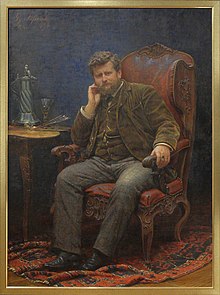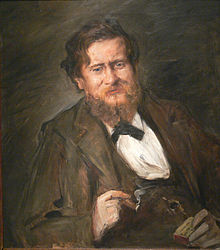Fritz Rumpf
Fritz Rumpf (born February 16, 1856 in Frankfurt am Main ; † July 23, 1927 in Potsdam ) (the elder) was a German painter, art collector, writer, from 1918 to 1923 honorary city councilor in Potsdam and builder of Villa Rumpf in Potsdam.
ancestors
Great grandfather
Johann Georg Friedrich Rumpf (1729–1774) was the second pastor in Oberroßbach. He was married to the pastor's daughter Susanne Marie. His ancestors had been evangelicals since the Reformation and were mainly pastors in Upper Hesse , especially in the Butzbach area . The main building of the Rumpf family can be traced back to 1480. He died in 1772, two years after the birth of his youngest son Friedrich Karl Rumpf (1772–1824). The eldest son Ludwig Daniel Philipp Rumpf (1762-NN) brought the half-orphan brother to Frankfurt am Main and financed him an excellent education.
Grandfather (paternal)
Friedrich Karl Rumpf (born September 16, 1772 in Oberroßbach, † October 7, 1824 in Gießen) was a German literary scholar, rhetorician, Protestant theologian and classical philologist. He married Christine Margarethe Fresenius (June 8, 1782 - April 23, 1873) in Frankfurt am Main on July 11, 1805, ten years his junior. She was a daughter of Ludwig Friedrich Wilhelm Fresenius, consistorial councilor, pastor and rector of the orphanage in Bad Homburg. Of their eight children, only four survived.
father
Remigius Ernst Friedrich Karl Rumpf (born September 30, 1811 in Gießen ; † January 6, 1893 in Frankfurt am Main), legal counsel for the city of Frankfurt am Main . Of the original eight siblings, four survived with him. These were
- Brother / uncle of Fritz - Jakob Heinrich Samuel Rumpf (born December 26, 1813 in Gießen † January 22, 1889 in Frankfurt am Main ) was a German educator and philologist
- Brother / uncle of Fritz - Wilhelm Heinrich Christian Rumpf (* July 2, 1822 in Gießen ; † June 23, 1885 in Gießen) philologist and librarian (custodian of the university library)
- Sister / aunt of Fritz - Marie Luise Gertrud Charlotte Rumpf (born August 27, 1819 in Gießen ; † April 23, 1873 in Wiesbaden ) married. September 21, 1845 with the secret councilor and chemist Carl Remigius Fresenius in Wiesbaden .
education
The father Remigius Ernst Friedrich Karl Rumpf initially insisted on commercial training for his son Fritz Rumpf in a Frankfurt bank, but also allowed him a longer stay in Lausanne to improve his French language skills. Then Fritz Rumpf was allowed to visit the Städelsche Kunstinstitut in Frankfurt and the Kassel art academy . He was strongly attracted by the rapidly developing Berlin art scene and so he moved to the new Reich capital to continue his studies there at the art academy.
His classmates from the Städel Art Institute, such as B. the painters Robert Forell from Frankfurt, as well as the landscape painter, sculptor and etcher Johann Georg Mohr , Oscar Goebel, Jacob Happ (1861-1936) and the sculptor Hugo Kaufmann (1868-1919) worked in Berlin .
family
Here he met Margarethe Gatterer (born March 8, 1862) from Swabia, whom he married in Frankfurt in Berlin without the knowledge of his family . He had six children with her.
All six siblings, like u. a.
- the eldest daughter Gertraut
- the eldest son Friedrich Karl Georg (1888–1949) (also called the younger Fritz Rumpf ), draftsman of the Oita yellow book with rhymes and illustrations about camp life in a Japanese prisoner of war camp and an important Japanologist
- the second oldest son Karl-Heinrich (1889–1914) artillery lieutenant, killed in 1914 in Lotz
- the youngest son Andreas Rumpf (1890–1966), German classical archaeologist
can be seen in the adjacent picture.
The family moved from Charlottenburg to nearby Potsdam . The landscape and architecture painter in this residence city particularly offered motifs from the Baroque and Rococo styles . This preference for motifs also motivated him to move to Würzburg in 1893 .
In 1893, after the death of his father Remigius Ernst Friedrich Karl Rumpf and other inheritances, he had become wealthy, so that Berlin friends made him aware of a cheap offer of a slightly raised waterfront property on the Holy See in Potsdam . Together with a Frankfurt school friend, the architect Gustav Meyer, he built a 16-room richly structured and decorated villa with a brick facade in the so-called Dutch Neo-Baroque with a high onion dome on a 2200 m² plot of land there from 1894 to 1895. It has 740 m² of living space, spread over four floors. Inside it was furnished with baroque columns and rococo decor in the salon and an empire room. In 1895 the so-called “Red Villa” on the Holy See in Potsdam was ready for occupancy. The Fritz Rumpf family maintained an open meeting place for artists in their villa in the Berlin suburb, Ludwig-Richter-Strasse 17. Many different artists such as Lovis Corinth or the actress Tila Durieux were guests here. As a city councilor, Rumpf campaigned for the preservation of the Potsdam cityscape. He was one of the initiators of the Potsdam Museum , which was founded in 1909 , was a sponsor of the Potsdam Messbildsammlung and a co-founder of the Potsdam Cultural Summer.
Closer circle of friends
During the lifetime of the builder Fritz Rumpf, artist friends who were friends lived in his villa, sometimes for several days. Henry van de Velde (1863–1957), Constantin Meunier (1831–1905), Max Liebermann (1847–1935), Max Slevogt (1868–1932), Walter Leistikow (1865–1908), Peter Behens (1868–1940), Heinich Schiestl (1864– ??), his brother Rudolf Schiestle (1878–1931), the Norwegian Bernt Grönvold (1859–1932) and Joseph Sattler (1867–1931) belonged to their closer circle of friends. In 1901 Lovis Corinth , the Impressionist painter , created the well-known family picture, Mrs. Margarethe Rumpf with the six children sitting on a gallery in the dining room and a separate portrait of Fritz Rumpf. The family picture has been in the possession of the Nationalgalerie Berlin since the death of Fritz Rumpf , while the portrait belongs to the Berlinische Galerie Berlin in the Gropiusbau .
Düsseldorf work
The surviving works by Fritz Rumpf (the elder) himself include a. his work on the artistic advisory board for costume design in the first season of 1905/06 at the Düsseldorf Theater for Louise Dumont and her husband Gustav Lindemann . Here he designed for the opening production of Stephen Philips “Paolo and Francesca” and Schiller's “ Kabale und Liebe ”, also the costumes for Hofmann's “ Elektra ” and Shakespeare's “ Was ihr wollt ”.
Summer house
Since 1913, the Fritz Rumpf family owned a spacious summer house in a wooded area in Schreiberhau, Silesia . Schreiberhau in the Giant Mountains was the largest village in Prussia in terms of area and the center of an artists' colony, the center of which was Carl Hauptmann (1858–1921) and his brother and Nobel Prize winner Gerhart Hauptmann (1862–1946) in nearby Agnetendorf .
The End
The consequences of the First World War and inflation also destroyed the Fritz Rumpf family's fortune. The splendid villa almost became an apartment building for the entire family.
Excursus on the "Red Villa"
Pictures of the interior of Villa Rumpf at that time are available. a. in the commemorative publication for the wife of Fritz Rumpf with the title: Margarethe Rumpf (* March 8, 1862) born Gatterer. For the 100th birthday on March 8, 1962. A private print: Bremerhaven 1962, as well as in the book of his daughter Gertraut Hofstetter: From the life of my father. In: Memories of Fritz Rumpf (1856–1927) on his 100th birthday on February 16, 1956; Edited by Gerhard Rumpf, Bremerhaven 1956 and an article by his daughter-in-law, the wife of his eldest son Friedrich Karl Georg (1888–1949) (also called the younger Fritz Rumpf) Marianne Rumpf with the title: Fritz Rumpf - Life and Work at a Glance.
It remained the family seat until 1945, despite the fact that the family's fortunes had been destroyed and wars and inflation. At the end of the Second World War, the villa burned down and was no longer rebuilt in its original state. The Soviets also confiscated this villa and left it to the French Military Liaison Commission (MVM), which then moved to Villa Seestrasse 41 . Artists and filmmakers used the ruined apartment. The Potsdam artist Peter Wilde lived in the building until 2000. At first he lived in an attic room and restored the building piece by piece. A layer of soot had to be removed from all objects - a consequence of the fire in 1945. The artists Alfred Schmidt , Christian Heinze and Manfred Nitsche also lived here in the building until they moved out . The villa has a garden pavilion with twisted wooden columns that are modeled on the columns in St. Peter's Basilica in Rome. In 2000 the fashion designer Wolfgang Joop bought the property by foreclosure auction of 4.85 million Deutschmarks. The prominent bidder, top model Nadja Auermann , was outbid. The Villa Rumpf was completely refurbished by Wolfgang Joop and then serves as a place of business for his fashion label Wunderkind. Wunderkind company vacated the property in 2011. A new buyer for Villa Rumpf is being sought. The purchase price should z. Are currently at 12 million euros.
tomb
Mausoleum on the New Cemetery Potsdam Location 7: Fritz Rumpf (1856–1927)
Works by Fritz Rumpf
- Man and his costume, described according to their essence. 1905.
- Amphitryon: Comedy in 3 Handge. and a prelude, based on Jean Baptiste Poquelin Molière. Oesterheld 1908.
- The peculiarity of the Potsdam cityscape and suggestions for its preservation. Lecture in the association of the house u. Landowner. 1913.
- When the soldiers march through the city ... - Soldier songs collected & provided with colored pictures by Fritz Rumpf . Erich Reiss Verlag, Berlin, 1913
literature
- Rumpf, Fritz . In: Hans Vollmer (Hrsg.): General lexicon of fine artists from antiquity to the present . Founded by Ulrich Thieme and Felix Becker . tape 29 : Rosa – Scheffauer . EA Seemann, Leipzig 1935, p. 204 .
- Fritz Rumpf 1856–1956. On the occasion of his 100th birthday on February 16, 1956. From a museum reprint for the Rumpf exhibition in Potsdam with photo by Fritz Rumpf
- Margarethe Rumpf b. Gatterer: On the 100th birthday on March 8, 1962. Private print, Bremerhaven.
- Gertraud Hofstetter: From my father's life. In: Gerhard Rumpf (Ed.): Memories of Fritz Rumpf. For the 100th birthday on February 16, 1956. Bremerhaven.
Web links
- Life of Fritz Rumpf with representation of the Villa Rumpf in Potsdam
- Photos of the renovated Villa Rumpf
- The Silesian Schreiberhau in the Giant Mountains
Individual evidence
- ↑ Hartmut Walravens: Rumpf, Fritz (Friedrich) Karl Georg. In: New German Biography (NDB). Volume 22, Duncker & Humblot, Berlin 2005, ISBN 3-428-11203-2 , p. 252 f. ( Digitized version ).
- ^ Digitized at tsingtau.info with the prisoners' résumés
| personal data | |
|---|---|
| SURNAME | Rumpf, Fritz |
| ALTERNATIVE NAMES | Rumpf, Fritz the Elder |
| BRIEF DESCRIPTION | German painter, art collector and writer |
| DATE OF BIRTH | February 16, 1856 |
| PLACE OF BIRTH | Frankfurt am Main |
| DATE OF DEATH | July 23, 1927 |
| Place of death | Potsdam |


